
![]()
Illegal Dumping Prevention Toolkit:
Site Maintenance and Controls
Cleanup projects require a coordinated planning, resource acquisition, and implementation effort. Necessary resources include labor, equipment, and funding. Labor resources can be sought from community and youth groups, local government organizations, corporations, or state or county corrections programs. Equipment such as containers, rakes, bags, gloves, shovels, heavy equipment, and trucks can be provided by public works or highway agencies and private companies. Funding for waste disposal may be provided by government agencies or through corporate donations. In some cases, removed materials such as brick and concrete can be used in a local fill project, thus reducing disposal costs.
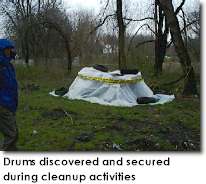 Local industry
and community groups can assist in landscaping and improving the physical appearance of
areas. Such beautification efforts can ward off potential dumpers.
Local industry
and community groups can assist in landscaping and improving the physical appearance of
areas. Such beautification efforts can ward off potential dumpers.
Sites must be cleaned up before a threat to public health and safety develops. State and federal cleanup programs, such as Superfund, may support urgent projects where a defined health or environmental threat exists.
A plan must be developed to remove any dumped materials and keep sites clean. Such a plan should be developed before a cleanup to ensure that the effort is not wasted.
Case Studies
- East St. Louis, Illinois. New Spirit, an organization representing over 30
neighborhoods, coordinates Community Cleanup Days. The events have resulted in removal of
over 166,000 tons of waste from inner city areas. New Spirit obtained 550 dumpsters
from a local waste management company as part of a supplemental environmental project
mandated by EPA. In addition, New Spirit uses volunteers from neighborhood organizations
for trash pickups and tire sweeps. Contact New Spirit, (618) 874-0312.
- Barberton, Ohio. The city health department presented certified cleanup orders to
owners of an illegal dump site. The vacant 2-acre site, which was located in a heavily
wooded area near a residence, contained 15-foot-high piles of household waste and scrap
tires. Several drums of hazardous waste were discovered during the cleanup. The city
forced the owners to hire a contractor to clean up the site and authorized funding to
cover about half the cost, in order to accelerate the cleanup. The entire cost of the
cleanup, estimated at $80,000, was recovered from the owners. Contact Mike Meusel,
Health Department, (330) 745-6067.
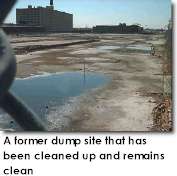 Pennsylvania. Pennsylvania CleanWays is a nonprofit
organization that helps communities clean up illegal dump sites in rural areas. As a
condition to providing assistance, before a cleanup Pennsylvania CleanWays works with
everyone involved to develop a plan to remove any materials dumped after the cleanup. The
"subsequent dump" team is made up of residents, law enforcement officials,
businesses, trash haulers, and landfill operators. Residents are taught what evidence to
look for, who the responsible enforcement officials are, how to contact them, and how to
remove trash if necessary. Residents bag and pile trash to make it easy for those who have
agreed to haul it away. To date, the program has cleaned up over 40 rural sites and 500
truckloads of waste. Contact Sue Wiseman, Pennsylvania CleanWays, (412) 836-4121.
Pennsylvania. Pennsylvania CleanWays is a nonprofit
organization that helps communities clean up illegal dump sites in rural areas. As a
condition to providing assistance, before a cleanup Pennsylvania CleanWays works with
everyone involved to develop a plan to remove any materials dumped after the cleanup. The
"subsequent dump" team is made up of residents, law enforcement officials,
businesses, trash haulers, and landfill operators. Residents are taught what evidence to
look for, who the responsible enforcement officials are, how to contact them, and how to
remove trash if necessary. Residents bag and pile trash to make it easy for those who have
agreed to haul it away. To date, the program has cleaned up over 40 rural sites and 500
truckloads of waste. Contact Sue Wiseman, Pennsylvania CleanWays, (412) 836-4121.
- Cook County, Illinois. The Department of Environmental Control, Sheriff’s
Department, Highway Department, and Forest Preserve District partner with communities to
clean up and maintain problem dump sites. Labor is provided by the Sheriff’s work
assistance program, and heavy equipment is provided by the Forest Preserve District. Waste
is transported for proper disposal and sites are secured with concrete barriers by the
Highway Department. Contact Charles Lagges, Department of Environmental Control,
(708) 865-6165.
- Detroit, Michigan. The city, the Michigan Department of Environmental Quality, and EPA targeted an abandoned factory being used for illegal dumping for cleanup and demolition. The 11-acre site had 21 buildings and was the site of several tire fires. Over 100,000 tires, 180 drums, and 30 truckloads of trash were removed from the site before demolition of the buildings. The area was fenced off and remains free of trash. The Redevelopment of Urban Sites team was established to address such sites. Contact Sarah Lile, Environmental Affairs Department, (313) 237-3090.
Many illegal dumping areas continue to experience problems after being cleaned up. Signs, lighting, and barriers can reduce or eliminate continued dumping in a given area. In addition, a plan needs to be in place to maintain the area and to promptly remove any materials that are dumped.
Cleaned-up sites can be converted to clean areas that no longer attract illegal dumping. Residents benefit from the availability of attractive space and improved property values.
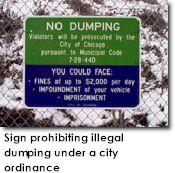 Signs
Signs
Some residents may be unaware that dumping is illegal and punishable by fines or prosecution. Use of "No Dumping" signs can be effective in preventing dumping and creating awareness of ordinances. Signs placed in a high-incidence area can specify fines and penalties or indicate that the area is under surveillance. The area around such signs must be kept clear of debris.
Lighting
Lighting can be an effective preventive measure in poorly lit or remote areas that experience "midnight dumping." Lighting increases the visibility of the crime and the chances of the offender’s being caught. Installing lighting requires an investment in electrical service and equipment.
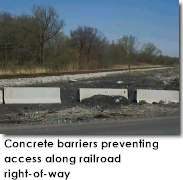 Barriers
Barriers
Barriers that limit access are critical for reducing and eliminating dumping in areas with a single point of entry. Fences, posts, berms, and concrete highway dividers prevent vehicle access. However, such barriers must not limit legal or emergency access to residences or buildings. In some cases, offenders may continue to dump at or over barriers instead of inside the restricted area.
Landscaping and Beautification
Landscaping and beautification efforts range from simply cutting grass and pulling weeds to establishing parks with benches, walkways, trees, picnic tables, grills, or playgrounds. Other efforts include painting murals, establishing gardens and flowerbeds, or converting sites into natural areas. Local schools and university cooperative extension services can assist at urban gardening sites or in projects involving establishment of plants requiring little or no maintenance. Communities where residents have limited access to public areas are ideal for such projects.
Case Studies
- Chicago, Illinois. The city conducts a program in which vacant lots are secured
to prevent additional dumping. Vertical, steel I-beams protruding a few feet above the
ground have proven to be the most effective barrier at over 500 locations. The city places
"No Dumping" signs that also clearly identify the penalties for dumping. The
signs have been effective in creating an awareness that illegal dumping is not tolerated. Contact
Alexandra Holt, Department of Environment, (312) 744-3172.
- Boston, Massachusetts. Boston’s beautification initiatives focus on
arranging partnerships, maintenance agreements, and adoption of space resulting in
cleanups, paintings, and plantings. The Youth Clean-Up Corps Red Shirts program sent over
2,300 youths into neighborhoods for 38 days, resulting in cleanup of 3,722 sites and
removal of 136,709 bags of trash weighing over 850 tons. The Broom to Bloom initiative
involves distribution of planters and hanging flower baskets along selected roadways. Contact
the Environmental Services Cabinet, (617) 635-3425.
- Los Angeles, California. The Nuisance Alley Conversion Project is a joint venture
between neighborhoods, the City Council, and the Department of Public Works. The project
involves fencing off "nuisance alleys and signing them over to residents for use as
parks. Over 13 alley conversions have taken place at an average cost of $12,000 each. Contact
the Environmental Hotline, (626) 458-3561.
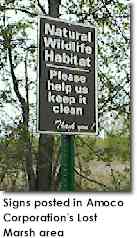 Whiting, Indiana. The Amoco
Corporation cleaned up a 10-acre property located between residences and a tank farm.
Beyond reintroducing native grasses, building bird boxes, eliminating invasive plant
species, and clearing pathways for trails, the Wildlife Enhancement Council provided
guidance on using community outreach and involvement to sustain the effort. The "Lost
Marsh" is now home to 23 bird and 59 plant species. Roadways bordering the tank farm
were beautified by planting flowerbeds, lawns, and trees. The project generated a renewed
sense of environmental stewardship and community pride, and it reawakened various
stakeholders to the value of small parcels of underdeveloped land. Contact Kevin
Sprague, Amoco Corporation, (219) 473-3148.
Whiting, Indiana. The Amoco
Corporation cleaned up a 10-acre property located between residences and a tank farm.
Beyond reintroducing native grasses, building bird boxes, eliminating invasive plant
species, and clearing pathways for trails, the Wildlife Enhancement Council provided
guidance on using community outreach and involvement to sustain the effort. The "Lost
Marsh" is now home to 23 bird and 59 plant species. Roadways bordering the tank farm
were beautified by planting flowerbeds, lawns, and trees. The project generated a renewed
sense of environmental stewardship and community pride, and it reawakened various
stakeholders to the value of small parcels of underdeveloped land. Contact Kevin
Sprague, Amoco Corporation, (219) 473-3148.